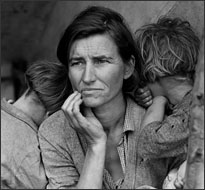January 2014 marks the 50th anniversary of President Lyndon B. Johnson’s famous State of the Union address in which he declared an “unconditional war on poverty.” In the months following his remarks, Congress passed the Economic Opportunity Act, designed to attack the roots of poverty, primarily by establishing education and training programs to better prepare people for employment. Other provisions included work-study grants for students, assistance for needy children and loans to poor rural families.
Despite this and five decades of other efforts to combat poverty, a December 2013 report by the National Council for Research on Women, “Gender Lens on Poverty Primer,” indicates that the problem remains pervasive in the United States. In particular, the report notes that according to the U.S. Census, “since 1966, women across all age groups have been more likely to live in poverty.”
The report brings together data from a wide range of sources, including the National Women’s Law Center, the Bureau of Labor Statistics, the Institute for Women’s Policy Research and academic papers. The report’s author, Rosa Cho, opens the paper by detailing the different categories of poverty, as well as the various ways to measure its prevalence. She highlights in particular the supplemental poverty measure, a tool developed in 2011 by the Census Bureau to better capture poverty rates. (The precise measurement of poverty remains a subject of some debate.)
Key findings cited in the report include:
- Over the past 40 years the percentage of Americans living in poverty has ranged between a low of 11.1% (1973) and a high of 15.2% (1983), according to the Census Bureau. In 2012, the official poverty rate was 15%; the supplemental poverty measure rate was 16%.
- For 2012 the Census Bureau indicated that the poverty rate was higher for women and girls than for men in every age group; for girls under 18 the rate was 22.3%, compared to 21.3% for boys; for women ages 18-64, it was 15.4% compared to 11.9% for men; for those over 65, it was 11% for women and 6.6% for men.
- Analysis by the Economic Policy Institute indicates that unemployment rates are usually lower for women — for example, in November 2013 the rate for women was 6.2% compared to 6.7% for men — but women are more likely to work in low-wage industries.
- According to the Institute for Women’s Policy Research, between 1993 and 2012 “the poverty gap between men and women was at the lowest in 2010, not because the women’s rate decreased but because the men’s rate increased.”
- A 2013 report published by the National Women’s Law Center notes: “Communities of color were particularly vulnerable to poverty — rates among Native American women, African American and Latina women over the age of 18 were 34.4%, 25.1% and 24.8%, respectively.”
“Poverty, especially among women, can be reduced by devoting more financial resources to the safety-net programs that both prevent poverty and assist those who are already living in poverty,” the author concludes. Options include reducing the gender pay gap, increasing the minimum wage, and increasing affordable housing and access to quality childcare.
For related research, see recent posts on the work/life balance for women, women in the labor force, and women’s well-being in U.S. cities.
Keywords: women and work, poverty


Expert Commentary